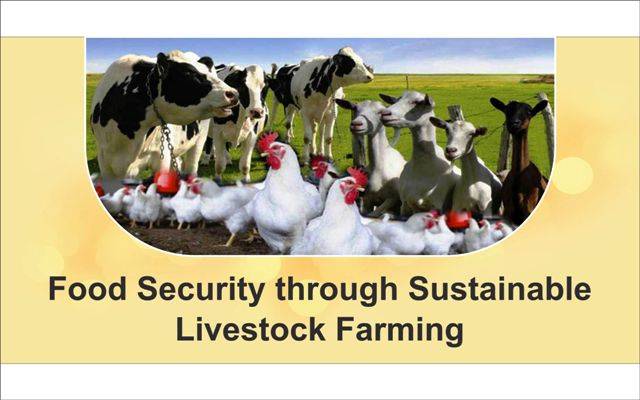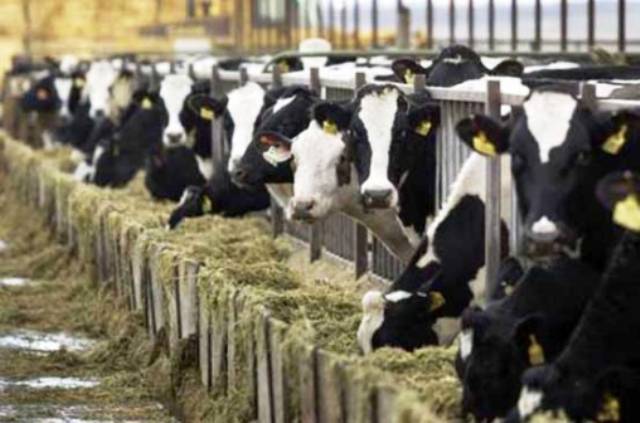
Introduction
Food security, as defined by the United Nations' Committee on World Food Security, is the condition in which all people, at all times, have physical, social and economic access to sufficient safe and nutritious food that meets their dietary needs and food preferences for an active and healthy life. With growing population and limited food resources, there comes a great responsibility on livestock sector to produce safe, nutritious, healthy and optimum food.
According to World Bank (2016), 30 per cent of Indian population lives below poverty line and more than 70 per cent of these reside in rural areas with meager means of nutrition and hence food insecurity. These masses can be targeted and brought under the umbrella of food security by promoting livestock farming amongst them and helping them to sustain their food demands through livestock farming. The above definition of food security fits well when it comes to food derived from livestock species as the protein derived from the animal sources is said to be complete. Certain livestock species like goats, backyard poultry, pigs, rabbits, etc. can be reared easily without using many inputs and their products lead to food security.

Systems of livestock farming for food security
1. Dairy Farming
With the largest inventory of bovine population and milk production, we possess great potential in the dairy sector that needs be tapped to ensure clean, safe and healthy milk for our population. Dairying is the main source of livelihood for our milk producers, majority of them either landless or marginal farmers possessing non-descript low producing dairy animals. These farmers can be trained to switch to scientific dairy practices by procuring elite dairy animals and better husbandry practices for increasing the milk production that will further enhance their livelihood and serve as complete food for others. Further, these farmers can utilize the healthcare services provided by the State Animal Husbandry Departments and practice artificial insemination for taking better progenies from their existing animals. The educated unemployed youth can also take up dairy farming as a source of employment for them through institutional support and produce clean and safe milk at economic prices that can be afforded by the poor.
-
Livestock that can be reared for milk production: Cattle, Buffalo, Goat, Camel.
-
Institutional Support for Dairy Farming: Dairy Entrepreneurship Development Scheme (DEDS).

2. Poultry Farming
Backyard Poultry Farming
This particular avenue can serve as a backbone for the “Food Security Model” for the rural poor. The government has supported many projects which led to the evolution of this sector among the rural areas. Backyard poultry can be reared with minimum inputs and only a night shelter is required for them. These birds require some attention at the early few days of their life and are designed to survive in atrocities of weather and feed. They can be reared easily in a group of 10-20 with minimal investment and can be easily handled by the children and ladies of the house. The birds in turn provide sustainable source of valuable protein in the form eggs and can be slaughtered to obtain meat at the end of their laying cycle, thus giving an edge to the farmers for low cost and healthy food. Many breeds are developed by ICAR-Central Avian Research Institute (CARI), Izatnagar for backyard farming and can be procured from CARI.
Broiler Farming
Broilers are those birds which are reared for meat production. The broilers grow to 1kg of weight in just 28 days with proper managemental conditions, so the profit can be obtained in a month’s time. The year round employment can be generated by the unemployed villagers by adopting broiler farming. Along with income, broiler farming serves as boost to nutritional security. With a slight knowledge, even children of the family and women can uptake the work of rearing broilers. Social and economic empowerment can be brought about by the clubbing the agriculture farming with broiler farming which can ultimately lead to food security.
Institutional Support for Poultry Farming
-
Poultry Venture Capital Fund Scheme (PVCFS)
-
Poultry Development Scheme (PDS)

3. Pig Farming
This species of livestock is the most profitable of all the livestock species. It can be started just by constructing a low cost shed and procuring 1 male and 2 female in the beginning of the enterprise. Low gestation period and high litter size makes it highly profitable. The pigs can be reared in semi-intensive to intensive type of rearing systems. A farmer with good management can obtain 3-4 crops per year and subsequently market them at good rates. Pigs can be used as food and also there are number of products like hams and sausages which can be made from pork but that require specialization. The poor farmers can rear them on kitchen waste and crop by-products and raise them for market. The pigs can lead to economic upliftment of the farmers and can serve as sustainable source of food too, thereby ensuring food security.

4. Goat Farming
Goat and sheep are called as ‘Mortgage Lifters’ and comes under the category of small ruminants. Goat is known as “Poor man’s cow” because of its multifarious benefits inspite of low investment. Goats are reared by poor sections of the society for milk primarily and chevon secondarily. The rural poor rely on goat’s milk for their nutrition and sale it after few years. Goats support the food web for the weak sections of the society. Goats can be reared with ease as they can thrive on weeds and bushes, tree tops and leaves for sufficing their appetite. Goat kids in five months and three crops can be taken in two years. Further twinning is common in goats and good flock can be maintained after following better husbandry practices. Goats can prove to be excellent source of milk, meat and fiber for the rural poor for sustaining their economy and nutrition.

5. Sheep Farming
Sheep serves to be an asset for population dwelling in hilly and temperate areas as these species of livestock are best suited to mountainous terrain. Sheep is not as prolific as goat but can be easily maintained in a household for mutton and wool production. It can be let for grazing for the day and can be housed during the night. Sheep has better body weight gain characteristic as compared to goats and require less labour for production. Sheep provides dependable source of income to the farmers in the form of mutton, wool and sale of animals thus providing stable economic environment to the farmers. The living standards of the farmer can be improved by the sale of wool. The income so obtained assists the livelihood of the farmers.

6. Rabbit Farming
Broiler rabbits are reared for meat purposes whereas fur breeds are used to harvest fur. Rabbit industry is proliferating in the hilly areas of the country predominantly and the fur of rabbit is used for making garments. The rabbits can be reared by constructing a fenced run and shelter for semi-intensive rearing whereas a low cost shed can be constructed for their intensive housing. If there is shortage of space, cage system of rearing can be adopted. Some people carry out backyard rabbit farming just like poultry and have proven to be useful. Rabbits are very prolific breeders and can give upto 12 kits at a time. The gestation period of 30-32 days further add to the advantage and one can take more than 6 crops easily in a year there producing meat for the whole year.
-
Institutional Support for Rabbit Farming: Integrated Development of Small Ruminants and Rabbit (IDSRR)
Food Security through Alternate Means
1. Draught Power Utilization
Animals can be used for their draught power for livelihood security of the poor farmers. Animals like ponies, mules, horses, camels, oxen, yak, mithun, elephant, etc. can be used for transportation of goods and ploughing of fields thereby ensuring economic stability to the livestock keepers and hence the food security.
2. Livestock Products Technology
Poor farmers who cannot even afford to purchase the animals or have paucity of funds, land and other resources for livestock farming can purchase milk, meat a nd eggs from the market and convert it into certain value added products which can be made without the use of sophisticated machines and much expertise. Ghee, Makkhan, Dahi, Paneer, Lassi, Khoa, Rabdi, Channa, Barfi and other sweets can be made easily from the milk and can be sold in the market at better prices and can also be consumed by the family. Likewise, meat pickle, egg pickle, kebabs, and other region specific meat recipes can be prepared for earning livelihood.
3. Alternate Poultry Farming
Along with the conventional farming of broilers and layers, other poultry species like turkey, emu, guinea fowl, Japanese quail, duck, ostrich, etc. can be reared by the farmers and sold at remunerative prices for stabilizing their income. Further, these also provide eggs and meat that can be consumed by the farming families.
4. Recreation
Animals like elephants, camels, horses, mules, etc. are used by the livestock keepers for recreation of the tourists at the tourist places and for sightseeing as well. Therefore, these animal species contribute to the day to day income of these livestock keepers and provide them with livelihood. People living near places of tourist interest can opt for this business and become economically stable.
5. Co-operatives
The co-operative movement in India has its roots deep into the history. Since the inception of Katra Milk Union in Allahabad, the co-operatives have grown in size and number. AMUL is a global brand now and not only providing economic stability but also raising the overall standards of living of the farmers connected with it. The co-operatives have regularized the payments to the farmers, introduced farmer and livestock development programmes, thereby strengthening the very fibre of rural India. Milk testing facilities by the co-operatives have ensured safe and healthy milk for the consumers and played a pivotal in ensuring food safety in the country.
Conclusion
Livestock is a very crucial and vital component of the very agriculture fiber of India. Not only it provides stability to the agricultural rural households at the time of crop failures but also sustain their food demands. Livestock based foods are complete in every aspect being rich in energy, protein and lipids essential for overall development of the human body. Sale of value added products paves way for an extra income to the farmer with which he can sustain his economy. Though, there needs to lay a strong emphasis on quality control and safety of such foods. This can be done easily by creating awareness among livestock farmers about Good Management Practices (GMPs) and Good Husbandry Practices (GHPs) which can ultimately lead to clean, safe and healthy for both the producing farmers and consumers ensuring food safety and food security.
Authors
SHEIKH FIRDOUS AHMAD
AMANDEEP SINGH
GURPREET KOUR
RICHA ARORA
PhD Scholar, Division of Animal Genetics
MVSc Scholar, Division of Extension Education
PhD Scholar, Division of Veterinary Biotechnology
ICAR-Indian Veterinary Research Institute, Izatnagar, Bareilly, Uttar Pradesh, India (243122).
MVSc Scholar, Department of Animal Genetics & Breeding, Guru Angad Dev Veterinary & Animal Sciences University, Ludhiana, Punjab, India (141004).
Email: [email protected]















